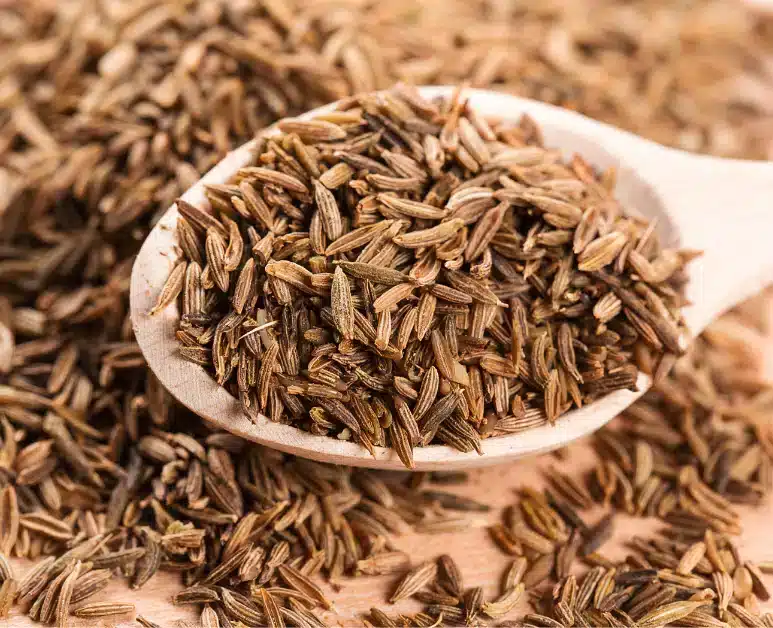Table of Contents
Do you want a versatile ingredient in your kitchen that lends a unique, earthy flavor to various dishes? I think it’s time to fill your spice jars with the goodness of cumin seeds. This staple spice in the culinary world not only has an appealing aroma but also imparts a peppery and smokey flavor. Moreover, it offers a plethora of health advantages that make it indispensable. So, in this article guide, we will unlock the secret to flavor cooking with all its nuances and intricacies to make your next dinner as delicious as a gourmet meal.
What Are Cumin Seeds?
Folks, if you are looking for ways to elevate the taste of your mundane dishes, it’s time to unlock the world of Cuminum cyminum. These seeds are obtained from the plant Cuminum cyminum, a member of the parsley family. The plant yields tiny, oval seeds, which are collected, dried, and used in recipes. These seeds have a warm, slightly bitter flavor and a strong, nutty flavor. These seeds are a popular spice which frequently used in spice blends and Mediterranean, Middle Eastern, Spanish, Portuguese, and Indian dishes, among other cuisines.
Difference between Ground and Cumin Seeds

Now that you know the origin of these seeds, it’s time we discuss their types. Basically, it comes in two forms. ground and whole. While ground cumin seeds and whole cumin seeds are both used for cooking, their tastes and attributes differ. This comparison will help you in recognizing the differences:
| Aspect | Whole Cumin Seeds | Ground Cumin Seeds |
| Flavor Profile | Earthy, slightly nutty | Subtle, warm, and earthy |
| Aroma | Strong and aromatic | More defined aroma when ground |
| Texture | Crunchy | Fine, powdered |
| Shelf Life | Longer shelf life | Shorter shelf life |
| Usage | Often toasted | Used directly |
Health Benefits
Having explored the differences between this seed spice in its two forms, these seeds have many health advantages in addition to their delicious flavor:
1. Digestive Health: The benefits of these seeds for the digestive system are well-known. They can aid in the relief of indigestion, gas, and bloating symptoms. Digestion is aided, and overall digestion is improved by the stimulation of the seeds’ formation of digestive enzymes.
2. Plenty of Nutrients: These seeds are a good source of potassium, calcium, magnesium, and iron. Iron is crucial for maintaining energy levels and preventing anemia.
3. Antioxidant Properties: The body is shielded from oxidative stress and damage from free radicals by the antioxidants found in these seeds. This may lower the chance of developing chronic illnesses and improve general health.
4. Anti-Inflammatory Effects: The seeds could benefit people with inflammatory diseases because of their anti-inflammatory qualities, which can help lower inflammation in the body.
5. Immune System Support: Compounds in these seeds strengthen the immune system, assisting the body in fending off diseases and infections.
Culinary Uses of Cumin Seed

These seeds are extremely versatile and have a wide range of culinary uses:
1. Spice Blends: A staple in many spice blends, such as garam masala, chili powder, and curry powder, is whole cumin seeds or cumin powder. It gives these mixtures more nuance and complexity.
2. Seasoning: Before adding whole cumin seeds to recipes, they are frequently toasted. Toasting intensifies their flavor by releasing their essential oil. This method is popular in Indian dishes, where hot oil is combined with these seeds to make a tasty basis for soups and curries.
3. Flavoring foods: Chefs often use these seeds to add flavor to a range of foods, including stews, soups, and rice with these seeds. You can also add them to marinades and sauces to impart a warm, earthy flavor.
4. Baking: These seeds can be used in baked goods, especially savory crackers or bread. They impart a distinct flavor that works well with herbs and cheese.
5. Beverages: Some cultures use cumin seeds to make tea or coffee, claiming that it improves digestion and offers health benefits.
Folks, cumin has several alternatives which add same richness and depth to the dishes, one of them is caraway seeds, which you can check out in this article.
Useful Tips for Cumin Seeds
- Toasting: To bring out the taste of the whole cumin seeds, roast them over medium heat in a dry skillet until fragrant. This enhances their flavor and brings out their natural oils.
- Grinding: For the freshest flavor, grind the whole seeds right before using. For this, a mortar and pestle or spice grinder will work well.
- Storage: To maintain the flavor of these seeds, store them in an airtight jar in a cool, dark place. For optimal flavor, use ground cumin seeds within six months of purchase.
You can learn about different recipes using cumin seeds in this article to add flavor to your dishes.
Conclusion
Summing up, Cumin seeds are a potent addition that enhances the taste of many foods. Whole cumin seeds or ground cumin seeds add a special richness and warmth to your food. These seeds are a great addition to your spice cabinet because they have several health advantages beyond their culinary use.

